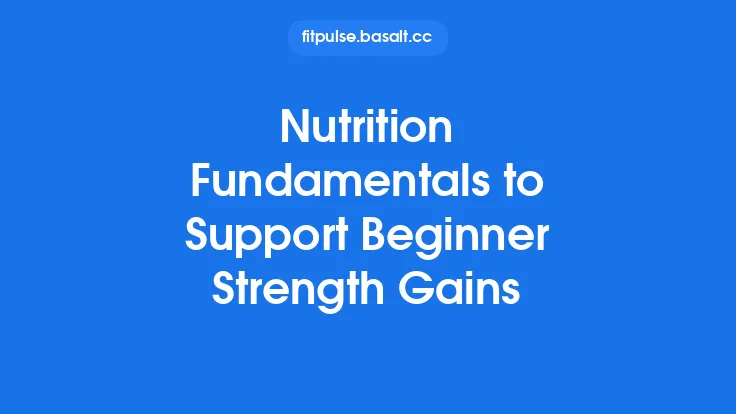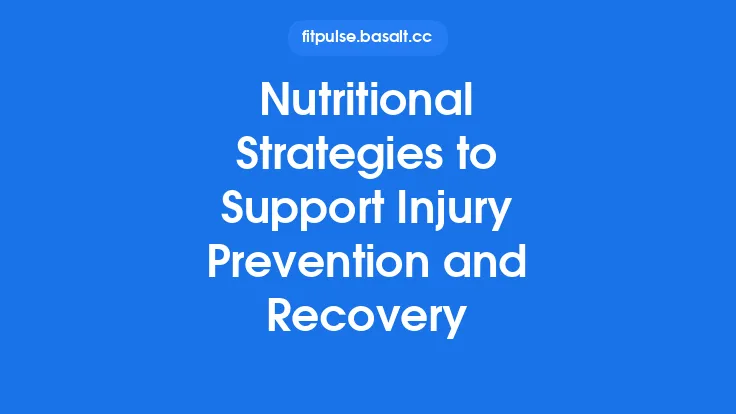Proper nutrition is the cornerstone of athletic development for young athletes. While training, skill acquisition, and mental preparation receive considerable attention, the fuel that powers the body often determines whether an athlete can truly capitalize on those efforts. For children and adolescents who are still growing, the nutritional demands are unique: they must support not only the energy expenditure of sport but also the rapid physical and cognitive development that occurs during these formative years. This article delves into the essential nutrients, timing strategies, hydration practices, and practical meal‑planning tips that empower growing athletes to perform at their best, recover efficiently, and maintain long‑term health.
Understanding the Energy Needs of Young Athletes
Basal Metabolic Rate and Activity Level
A child’s basal metabolic rate (BMR) – the energy required for basic physiological functions – is already higher per kilogram of body weight than that of an adult. When sport is added to the mix, total daily energy expenditure (TDEE) can increase dramatically. The exact caloric requirement varies based on age, sex, body size, sport type, training intensity, and duration. As a rule of thumb:
- Light‑to‑moderate activity (e.g., recreational soccer, swimming 2–3 times/week): 40–50 kcal per kilogram of body weight.
- High‑intensity or multiple‑session training (e.g., competitive basketball, track & field, gymnastics): 50–70 kcal per kilogram of body weight.
These ranges are guidelines; individual monitoring (e.g., tracking weight trends, performance, and subjective energy levels) is essential to fine‑tune intake.
Macronutrient Distribution
| Nutrient | Recommended Percentage of Total Calories | Role in Young Athletes |
|---|---|---|
| Carbohydrates | 55–65% | Primary fuel for high‑intensity effort; replenishes muscle glycogen. |
| Protein | 15–20% | Supports muscle repair, growth, and hormone synthesis. |
| Fat | 20–30% | Provides essential fatty acids, supports hormone production, and serves as a secondary energy source. |
Because children have higher relative carbohydrate oxidation rates, ensuring adequate carb intake is especially critical for sustaining performance and preventing early fatigue.
Key Micronutrients for Growth and Performance
Calcium and Vitamin D
- Why they matter: Calcium is vital for bone mineralization, while vitamin D enhances calcium absorption and supports immune function.
- Sources: Dairy products (milk, yogurt, cheese), fortified plant milks, leafy greens (kale, bok choy), and sunlight exposure for vitamin D synthesis.
- Daily targets: 1,300 mg of calcium and 600–1,000 IU of vitamin D for adolescents (varies slightly by age and sex).
Iron
- Why it matters: Iron is a component of hemoglobin, which transports oxygen to working muscles. Deficiency can lead to reduced aerobic capacity and fatigue.
- Sources: Lean red meat, poultry, fish, beans, lentils, fortified cereals, and spinach. Pair plant‑based iron sources with vitamin C‑rich foods (citrus, strawberries) to improve absorption.
- Daily targets: 8 mg for boys (14–18 y) and 15 mg for girls (14–18 y) due to menstrual losses.
Zinc
- Why it matters: Zinc supports immune function, protein synthesis, and wound healing—critical for athletes who experience frequent micro‑trauma.
- Sources: Meat, shellfish, nuts, seeds, whole grains, and dairy.
- Daily targets: 8 mg (girls 14–18 y) and 11 mg (boys 14–18 y).
B‑Vitamins (B6, B12, Folate, Riboflavin, Niacin)
- Why they matter: These vitamins act as co‑enzymes in energy metabolism, converting carbohydrates, fats, and proteins into usable ATP.
- Sources: Whole grains, eggs, dairy, meat, legumes, and leafy vegetables.
Electrolytes (Sodium, Potassium, Magnesium, Chloride)
- Why they matter: Electrolytes regulate fluid balance, nerve transmission, and muscle contraction. Young athletes lose electrolytes through sweat, especially in hot environments.
- Sources: Bananas, potatoes, yogurt, nuts, seeds, and modest amounts of table salt.
Protein: Quality Over Quantity
While the overall protein percentage is modest, the quality and timing of protein intake are pivotal for growth and recovery.
- Complete proteins contain all nine essential amino acids. Animal sources (meat, dairy, eggs) are naturally complete. For vegetarian athletes, combine complementary plant proteins (e.g., beans + rice, hummus + whole‑grain pita) within the same day.
- Leucine‑rich foods (dairy, whey, soy, chicken) stimulate muscle protein synthesis more effectively.
- Recommended intake: 1.2–1.6 g per kilogram of body weight per day for active youth, slightly higher than the 0.8 g/kg baseline for sedentary peers.
Carbohydrate Timing: Fueling Performance and Recovery
Pre‑Exercise
- Goal: Maximize glycogen stores and maintain stable blood glucose.
- What to eat: A carbohydrate‑rich snack 30–60 minutes before activity (e.g., a banana with a small amount of nut butter, a slice of toast with honey). Aim for 1–2 g of carbs per kilogram of body weight in the 3–4 hours preceding longer sessions.
During Exercise
- Goal: Sustain blood glucose for events lasting >60 minutes.
- What to consume: 30–60 g of easily digestible carbs per hour (sports drinks, gels, fruit slices). For younger athletes, a modest approach (e.g., a small sports drink) is sufficient; avoid excessive sugar that could cause gastrointestinal distress.
Post‑Exercise
- Goal: Replenish glycogen, initiate muscle repair, and rehydrate.
- What to eat: A carbohydrate‑protein blend within 30 minutes of finishing activity, ideally a 3:1 or 4:1 carb‑to‑protein ratio (e.g., chocolate milk, a smoothie with fruit and Greek yogurt). This window enhances glycogen resynthesis and supports protein synthesis.
Hydration: More Than Just Water
Adequate fluid intake is essential for thermoregulation, cognitive function, and cardiovascular performance.
- Baseline: Encourage regular water consumption throughout the day (≈30–35 ml per kilogram of body weight). For a 60 kg adolescent, that translates to roughly 2 L of water daily.
- Pre‑exercise: Drink 200–300 ml of water 2–3 hours before activity, and another 150–250 ml 20–30 minutes prior.
- During exercise: Aim for 150–250 ml of fluid every 15–20 minutes, adjusting for temperature, humidity, and sweat rate. Sports drinks containing 6–8% carbohydrate and electrolytes are useful for sessions >60 minutes.
- Post‑exercise: Replace fluid losses by drinking 1.5 L of water for every kilogram of body weight lost during activity (weigh athletes before and after to estimate loss).
Practical Meal Planning for Busy Families
Breakfast Ideas
- Oatmeal bowl: Rolled oats cooked with milk, topped with berries, a drizzle of honey, and a sprinkle of chopped nuts.
- Greek yogurt parfait: Full‑fat Greek yogurt layered with granola, sliced banana, and a spoonful of nut butter.
- Whole‑grain toast: Avocado spread with a poached egg and a side of orange slices.
Lunch Options
- Turkey and cheese wrap: Whole‑grain tortilla, sliced turkey, cheddar, lettuce, and a thin spread of hummus; serve with carrot sticks and an apple.
- Quinoa salad: Cooked quinoa mixed with black beans, corn, diced bell peppers, cilantro, and a lime‑olive‑oil dressing; add grilled chicken for extra protein.
- Pasta bowl: Whole‑wheat pasta tossed with marinara sauce, lean ground beef or lentils, and a side of steamed broccoli.
Dinner Strategies
- Stir‑fry: Lean beef or tofu, mixed vegetables (broccoli, snap peas, carrots), and brown rice; season with low‑sodium soy sauce.
- Baked salmon: Served with sweet potato wedges and a green salad dressed with olive oil and lemon.
- Chili: Ground turkey or beans, tomatoes, kidney beans, and spices; accompany with cornbread and a side of mixed greens.
Snack Solutions
- Fruit & nut butter: Apple slices with almond butter.
- Cheese & whole‑grain crackers: String cheese with a handful of whole‑grain crackers.
- Energy‑boosting smoothie: Blend milk, frozen berries, a scoop of whey or plant protein, and a spoonful of oats.
Supplementation: When (and When Not) to Use
For most youth athletes, a well‑balanced diet provides all necessary nutrients. However, certain circumstances may warrant supplementation:
- Vitamin D: In regions with limited sunlight, a daily 600–1,000 IU supplement can help maintain optimal levels.
- Iron: Only under medical supervision after confirming deficiency via blood tests.
- Omega‑3 fatty acids: A modest fish‑oil supplement (EPA/DHA) can support inflammation control and cognitive function, especially for athletes with limited fish intake.
- Protein powders: Generally unnecessary if dietary protein targets are met; if used, choose high‑quality, low‑additive options and keep portions modest (≈20 g per serving).
Monitoring Nutrition Without Over‑Medicalizing
While it is important to ensure adequate intake, the focus should remain on fostering a positive relationship with food rather than strict tracking. Simple, observable indicators can guide adjustments:
- Growth trends: Consistent upward trajectory on growth charts suggests adequate nutrition.
- Energy levels: Frequent fatigue, irritability, or difficulty concentrating may signal insufficient caloric or nutrient intake.
- Performance markers: Declining endurance, strength, or skill execution can be early signs of nutritional shortfalls.
- Recovery speed: Prolonged muscle soreness or frequent illnesses may indicate suboptimal recovery nutrition.
If concerns arise, a registered dietitian with experience in sports nutrition for youth should be consulted rather than relying on generic online advice.
Creating a Nutrition‑Friendly Environment
- Family involvement: Parents and caregivers set the tone by providing balanced meals and modeling healthy eating habits.
- Team snacks: Encourage coaches to supply nutrient‑dense options (e.g., fruit, yogurt, trail mix) rather than sugary treats.
- Education: Simple workshops for athletes and families on reading nutrition labels, portion sizes, and the importance of timing can empower informed choices.
- Flexibility: Recognize cultural food preferences and adapt meal plans to respect traditions while meeting nutritional goals.
Summary of Key Takeaways
- Energy balance is foundational – match caloric intake to the combined demands of growth and sport.
- Prioritize carbohydrates for fuel, protein for repair, and healthy fats for hormone health.
- Micronutrients matter – calcium, vitamin D, iron, zinc, B‑vitamins, and electrolytes are essential for bone health, oxygen transport, and overall performance.
- Timing enhances outcomes – strategic pre‑, during, and post‑exercise nutrition optimizes energy availability and recovery.
- Hydration is non‑negotiable – regular water intake, supplemented with electrolytes for longer sessions, supports thermoregulation and cognition.
- Practical, family‑centered meal planning makes consistent nutrition achievable amidst busy schedules.
- Supplementation is a last resort – focus on whole foods; use supplements only when deficiencies are identified.
- Monitor through simple cues – growth patterns, energy levels, performance, and recovery provide practical feedback loops.
- Cultivate a supportive environment – involve families, coaches, and educators to reinforce healthy eating habits.
By integrating these nutrition essentials into daily routines, growing athletes can unlock their full potential on the field, court, or track while laying the groundwork for lifelong health and athletic enjoyment.





